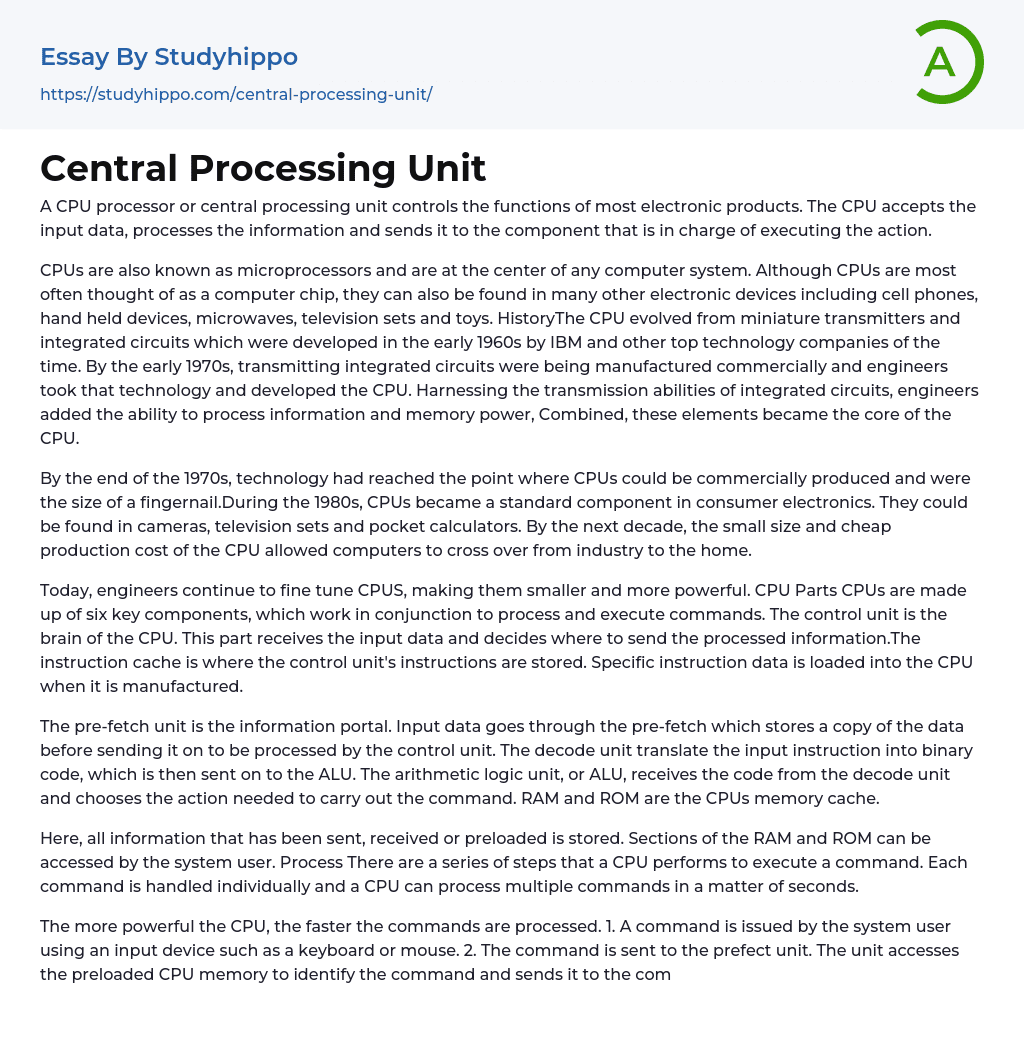A CPU processor or central processing unit controls the functions of most electronic products. The CPU accepts the input data, processes the information and sends it to the component that is in charge of executing the action.
CPUs are also known as microprocessors and are at the center of any computer system. Although CPUs are most often thought of as a computer chip, they can also be found in many other electronic devices including cell phones, hand held devices, microwaves, television sets and toys. HistoryThe CPU evolved from miniature transmitters and integrated circuits which were developed in the early 1960s by IBM and other top technology companies of the time. By the early 1970s, transmitting integrated circuits were being manufactured commercially and engineers took that technology and developed the CPU. Harnessing the transmission abilities of
...integrated circuits, engineers added the ability to process information and memory power, Combined, these elements became the core of the CPU.
By the end of the 1970s, technology had reached the point where CPUs could be commercially produced and were the size of a fingernail.During the 1980s, CPUs became a standard component in consumer electronics. They could be found in cameras, television sets and pocket calculators. By the next decade, the small size and cheap production cost of the CPU allowed computers to cross over from industry to the home.
Today, engineers continue to fine tune CPUS, making them smaller and more powerful. CPU Parts CPUs are made up of six key components, which work in conjunction to process and execute commands. The control unit is the brain of the CPU. This part receives the input data and decides where to send the processed
information.The instruction cache is where the control unit's instructions are stored. Specific instruction data is loaded into the CPU when it is manufactured.
The pre-fetch unit is the information portal. Input data goes through the pre-fetch which stores a copy of the data before sending it on to be processed by the control unit. The decode unit translate the input instruction into binary code, which is then sent on to the ALU. The arithmetic logic unit, or ALU, receives the code from the decode unit and chooses the action needed to carry out the command. RAM and ROM are the CPUs memory cache.
Here, all information that has been sent, received or preloaded is stored. Sections of the RAM and ROM can be accessed by the system user. Process There are a series of steps that a CPU performs to execute a command. Each command is handled individually and a CPU can process multiple commands in a matter of seconds.
The more powerful the CPU, the faster the commands are processed. 1. A command is issued by the system user using an input device such as a keyboard or mouse. 2. The command is sent to the prefect unit. The unit accesses the preloaded CPU memory to identify the command and sends it to the command unit.
. The command unit determines what steps come next. This data is passed on to the decode unit. 4. The decode unit transfer the data into binary code and sends it to the ALU. 5.
The ALU changes the raw data into an actual command. 6. The ALU sends a copy of the command to the RAM or ROM
before sending it back to the command unit. 7. The command unit sends the code to the part of the system that will actual perform the action.
8. The action is executed and the result is sent back to the user. Types There are different types of CPUs; each type comes with varying degrees of speed memory and preset instructions.The larger the CPU, the faster it can process, store and execute commands. A single core CPU is the smallest unit available. It is usually found in smaller appliances that only perform a simple set of actions such as a remote control or toy.
Dual-core CPUs contains two command units and contain enough power and memory for most personal computers. Multi-core CPUS contain multiple command units. They are mainly used by large industrial electronic devices, servers, and network work stations. Sizes CPU size refers to the unit's power to perform tasks and the amount of memory space it contains.
CPU size is measured in binary digits and is called bits. Originally, CPUs contained 4-bits but that has since evolved into 8 bits. 8 bit CPUs are the smallest and slowest components available and are used mostly in toys or household appliances. 16-bit and 32-bit have become the standard CPU size and can be found in personal computers, laptops, cell phones and other electronic devices that can perform a variety of tasks. 64-bit CPUs are becoming increasingly popular in high-end personal computers and laptops. There are also larger CPUs which are usually used for industrial purposes.
- Computer File essays
- Desktop Computer essays
- Servers essays
- Flowchart essays
- Integrated Circuit essays
- Tracking system essays
- Hard Disk Drive essays
- Data collection essays
- Graphic Design essays
- Data Mining essays
- Cryptography essays
- Internet essays
- Network Security essays
- Android essays
- Computer Security essays
- World Wide Web essays
- Website essays
- Computer Network essays
- Application Software essays
- Computer Programming essays
- Computer Software essays
- Benchmark essays
- Information Systems essays
- Email essays
- Hypertext Transfer Protocol essays
- Marshall Mcluhan essays
- Virtual Learning Environment essays
- Web Search essays
- Etiquette essays
- Mainstream essays
- Vodafone essays
- Web Search Engine essays
- Networking essays
- Telecommunication essays
- Network Topology essays
- Telecommunications essays
- Programming Languages essays
- Object-Oriented Programming essays
- Java essays
- Biscuit essays
- chips essays
- Cola essays
- Pizza Hut essays
- snack foods essays
- Camera essays
- Cell Phones essays
- Computer essays
- Ipod essays
- Smartphone essays
- Computer Components essays




